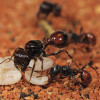Evolution on a grand scale - the sort of evolution that produced humans from our monkey-like ancestors - takes millions of years. But although these kind of timescales can't be studied in the lab, researchers at Michigan State University have been running an evolutionary experiment over 21 years that shows natural selection at work.
The researchers periodically froze samples of bugs from the culture, and analysed them using modern gene sequencing technology. Although the study started 21 years ago, it's taken until now for genomic technology to be able to do justice to such an experiment.
By the 20,000 generation halfway mark, the scientists discovered 45 mutations in the surviving cells. And as you might expect, these mutations gave a survival advantage to the bacteria that carried them. The experiment also revealed interesting relationships between the speed at which organisms adapt, compared to the rate of mutation in their genomes. Lenski says "The genome was evolving along at a surprisingly constant rate, even as the adaptation of the bacteria slowed down a lot. But then suddenly the mutation rate jumped way up, and a new dynamic relationship was established."
The team found that a mutation involved in DNA metabolism occurred after around 26,000 generations, and this meant that the chances of mutations happening elsewhere in the genome rose dramatically - so by generation 40,000 there were 653 mutations, compared with the 45 found at the half-way mark.
Obviously, in only 21 years we're not going to see the evolution of anything other than slightly better bacteria. But the research could shed light on other situations where genomes evolve as organisms adapt - such as in the development of cancer, or microbial infections. And it could also be useful for industrial scientists who grow bacteria to produce enzymes and drugs, to improve the performance of their bugs.
- Previous Stresses and strains shape embryos
- Next The Taste of Fizz










Comments
Add a comment